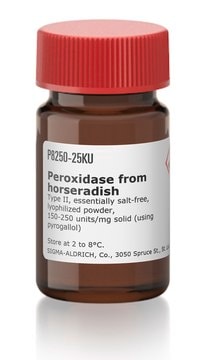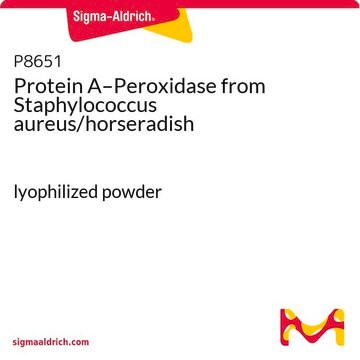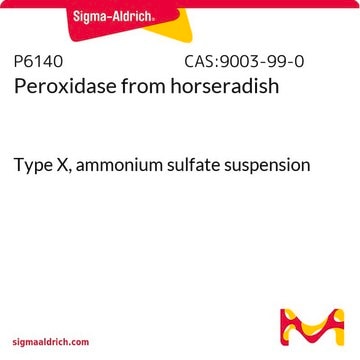추천 제품
생물학적 소스
horseradish
Quality Level
형태
lyophilized
특이 활성도
800 units/mg protein (at 25 °C with ABTS and H2O2 as substrate (pH 5.0).)
포장
pkg of 8 mg (~40 mg lyophilizate)
제조업체/상표
Roche
최적 pH
6.0-6.5
배송 상태
wet ice
저장 온도
2-8°C
일반 설명
Donor: hydrogen-peroxide oxidoreductase
Reagent for the labeling of water-soluble substances carrying primary amino groups with peroxidase from horseradish (HRP).
Capacity: sufficient for approximately 6 mg IgG.
Reagent for the labeling of water-soluble substances carrying primary amino groups with peroxidase from horseradish (HRP).
Capacity: sufficient for approximately 6 mg IgG.
Peroxidase (POD) is an enzyme that includes a group of specific enzymes such as NAD peroxidase, NADP peroxidase, fattyacid peroxidase and a group of non specific enzymes from various sources. It is present in animals, higher plants and other organisms.
애플리케이션
Peroxidase (POD), activated has been used in terminal deoxyribonucleotidyl transferase (TDT)-mediated dUTP-digoxigenin nick end labeling (TUNEL) staining and immunohistochemistry.
The enzyme can be used without pre-activation for labeling water-soluble substances with reactive and accessible primary amino groups (e.g., peptides or proteins) with peroxidase for use in analytical methods. It is particularly suitable for the coupling of antibodies (Ig, Ig Fab, and Ig F(ab′)2 fragments from rabbit, mouse, sheep, and goat) with peroxidase. The resulting conjugate is optimal for use in immunochemical detection systems, for example, ELISA, immunohistochemistry, and immunoblotting procedures.
생화학적/생리학적 작용
Peroxidase (POD) helps in the dehydrogenation of several organic compounds like phenols, aromatic amines, hydroquinones etc.
품질
Isoenzymes: >90% isoenzyme C (HPLC)
Purity number: 3.0 - 3.5 (A403/A275)
Purity number: 3.0 - 3.5 (A403/A275)
제조 메모
Stabilizers: Product is stabilized with sucrose.
Working concentration: 1:4,000 to 1:10,000
For ELISA
Working solution: Preparation of the solutions, (15 to 25 °C)
1. 1 M Sodium carbonate/-hydrogencarbonate solution, pH 9.4
1 M Na2CO3: Dissolve 10.6 g Na2CO3 in 80 ml double-dist. water and make up to 100 ml.
1 M NaHCO3: Dissolve 8.4 g NaHCO3 in 80 ml double-dist. water and make up to 100 ml.
Adjust the pH of the NaHCO3 solution to 9.4 by adding Na2CO3 solution.
2. 100 mM Sodium carbonate/-hydrogencarbonate solution, pH 9.8
Dilute 10 ml solution 1 to 100 ml with double-dist. water.
3. 200 mM Sodium borohydride solution
NB: Prepare the solution immediately prior to use and keep cold on ice. Dissolve 8 mg NaBH4 in 1 ml cold double-dist. water.
4. 2 M Triethanolamine solution, pH 8.0
Dilute 2.66 ml triethanolamine with 3 ml double-dist. water, adjust the pH to 8.0 with 25% HCI and make up to 10 ml with double-dist. water.
5. 1 M Glycine solution, pH 7.0
Dissolve 0.75 g glycine in ca. 6 ml double-dist. water, adjust to pH 7.0 with 0.1 M NaOH, and make up to 10 ml with double-dist. water.
6. PBS (phosphate-buffered saline); glycine; pH 7.4.
10 mM Potassium phosphate, 200 mM NaCI, 10 mM glycine, pH 7.5.
7. Antibody solution
0.3 ml required for each labeling reaction. The IgG concentration of the solution to be used is c = 4 mg/ml (3.8–42 mg/ml). This value is critical for the coupling and hence should be checked photo-metrically for every test and adjusted if necessary: A280nm, 1cm, 1 mg/ml = 1.40.
NB: Do not use preservatives (e.g., sodium azide) and stabilizers (e.g., albumin).
Stability of the solutions
Solutions 1, 2, 4, 5 and 6 are stable for 1 week at 2 to 8 °C. Solutions 3 and 7 should always be prepared immediately prior to use.
Storage conditions (working solution): The reconstituted solution is stable for 3 months at 2 to 8 °C. The solution can be aliquoted and shock-frozen at -60 °C or below, and then stored at -15 to -25 °C; a loss of activity of 10–20 % can result.
Working concentration: 1:4,000 to 1:10,000
For ELISA
Working solution: Preparation of the solutions, (15 to 25 °C)
1. 1 M Sodium carbonate/-hydrogencarbonate solution, pH 9.4
1 M Na2CO3: Dissolve 10.6 g Na2CO3 in 80 ml double-dist. water and make up to 100 ml.
1 M NaHCO3: Dissolve 8.4 g NaHCO3 in 80 ml double-dist. water and make up to 100 ml.
Adjust the pH of the NaHCO3 solution to 9.4 by adding Na2CO3 solution.
2. 100 mM Sodium carbonate/-hydrogencarbonate solution, pH 9.8
Dilute 10 ml solution 1 to 100 ml with double-dist. water.
3. 200 mM Sodium borohydride solution
NB: Prepare the solution immediately prior to use and keep cold on ice. Dissolve 8 mg NaBH4 in 1 ml cold double-dist. water.
4. 2 M Triethanolamine solution, pH 8.0
Dilute 2.66 ml triethanolamine with 3 ml double-dist. water, adjust the pH to 8.0 with 25% HCI and make up to 10 ml with double-dist. water.
5. 1 M Glycine solution, pH 7.0
Dissolve 0.75 g glycine in ca. 6 ml double-dist. water, adjust to pH 7.0 with 0.1 M NaOH, and make up to 10 ml with double-dist. water.
6. PBS (phosphate-buffered saline); glycine; pH 7.4.
10 mM Potassium phosphate, 200 mM NaCI, 10 mM glycine, pH 7.5.
- Solution A (K2HPO4): Dissolve 4.56 g K2HPO4 × 3 H2O, 23.4 g NaCI, and 1.5 g glycine in ca. 1,500 ml double-dist. water and make up to 2000 ml with double-dist. water.
- Solution B (KH2PO4): Dissolve 2.72 g KH2PO4, 23.4 g NaCI, and 1.5 g glycine in ca. 1,500 ml double-dist. water and make up to 2,000 ml with double-dist. water.
- PBS: Whilst controlling pH, add sufficient solution B to solution A until the pH is 7.4.
7. Antibody solution
0.3 ml required for each labeling reaction. The IgG concentration of the solution to be used is c = 4 mg/ml (3.8–42 mg/ml). This value is critical for the coupling and hence should be checked photo-metrically for every test and adjusted if necessary: A280nm, 1cm, 1 mg/ml = 1.40.
NB: Do not use preservatives (e.g., sodium azide) and stabilizers (e.g., albumin).
- Immunoglobulin, salt-free, lyophilized:
- Immunoglobulin in buffer:
Stability of the solutions
Solutions 1, 2, 4, 5 and 6 are stable for 1 week at 2 to 8 °C. Solutions 3 and 7 should always be prepared immediately prior to use.
Storage conditions (working solution): The reconstituted solution is stable for 3 months at 2 to 8 °C. The solution can be aliquoted and shock-frozen at -60 °C or below, and then stored at -15 to -25 °C; a loss of activity of 10–20 % can result.
재구성
Dissolving the lyophilizate in 0.5 ml double-dist. Water produces a peroxidase concentration of 16 mg/ml.
기타 정보
For life science research only. Not for use in diagnostic procedures.
신호어
Danger
유해 및 위험 성명서
Hazard Classifications
Resp. Sens. 1 - Skin Sens. 1
Storage Class Code
11 - Combustible Solids
WGK
WGK 1
Flash Point (°F)
does not flash
Flash Point (°C)
does not flash
시험 성적서(COA)
제품의 로트/배치 번호를 입력하여 시험 성적서(COA)을 검색하십시오. 로트 및 배치 번호는 제품 라벨에 있는 ‘로트’ 또는 ‘배치’라는 용어 뒤에서 찾을 수 있습니다.
이미 열람한 고객
Inhibition of SNK?SPAR signaling pathway promotes the restoration of motor function in a rat model of ischemic stroke.
Fan QY, et al.
Journal of Cellular Biochemistry, 119(1), 1093-1110 (2018)
Effects of rehabilitation training on apoptosis of nerve cells and the recovery of neural and motor functions in rats with ischemic stroke through the PI3K/Akt and Nrf2/ARE signaling pathways.
Jin XF, et al.
Brain Research Bulletin, 134, 236-245 (2017)
Biochemical Methods (1996)
A monoclonal antibody for the detection of SNAP/CLIP-tagged proteins.
Puettmann C, et al.
Immunology Letters, 150(1-2), 69-74 (2013)
Hongmei Zhao et al.
Bioengineered, 13(4), 9928-9944 (2022-04-15)
Type 2 diabetes mellitus (T2DM) can enhance the risk of mycobacterium tuberculosis (Mtb) infection and aggravate pulmonary tuberculosis (PTB). This study intended to explore the function of phosphatase and tensin homolog (PTEN) in T2DM-PTB and the molecules involved. Mice were
자사의 과학자팀은 생명 과학, 재료 과학, 화학 합성, 크로마토그래피, 분석 및 기타 많은 영역을 포함한 모든 과학 분야에 경험이 있습니다..
고객지원팀으로 연락바랍니다.








